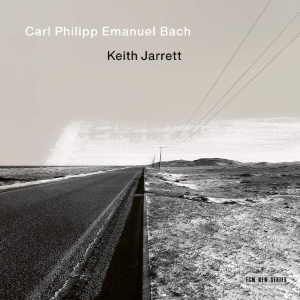
Carl Philipp Emmanuel Bach (1714-1788)
Württemburg Sonatas Wq49
Keith Jarrett (piano)
rec. 1994, Cavelight Studio, USA
Reviewed as a digital download from a press preview
ECM 4858495 [85]
It is always a good idea for a critic to set aside any preconceptions they may have born of the reputation of a performer whose new recording they are reviewing. Usually, this is a matter of banishing prejudices rather than favourable prior impressions. In the unusual case of Keith Jarrett, both sorts of prejudgments apply. He is one of, if not the, greatest jazz pianists of all time but his frequent forays into the world of straight classical haven’t always impressed me greatly. The contrast between jazz Jarrett and the classical one is very pronounced. Particularly when improvising, Jarrett’s jazz could hardly be freer, wilder or more torrential. His classical albums, on the other hand, have all erred too much on the side of caution as if he were determined to be taken seriously as a bona fide classical pianist. And a bona fide classical pianist he certainly is though his jazz persona – the reason he is one of the greatest musicians ever to strike the ivories – is barely to be seen. Such are the preconceptions weighing on my mind as I approached this new of issue of CPE Bach sonatas.
There is an another, much sadder context to the present release since in 2018 a series of strokes forced him into retirement. This recording was taped in 1994.
Returning to preconceptions, it is hard not to think in advance that Jarrett and the music of CPE Bach are potentially a match made in heaven. The importance of dramatic (sometimes melodramatic) rhetorical flourishes, the quasi improvisatory manner, the sometimes febrile emotional temperature – all of these qualities of the music of JS Bach’s eldest son seem tailor made for jazz Jarrett. The question is how does classical Jarrett get on with them?
I have lately taken the music of CPE Bach up as a bit of cause – it is wonderful stuff and deserves to step out of the lengthy shadow of Johann Sebastian is the essence of my manifesto – and this is the third recording of his music I have reviewed in a row. My point of comparison in considering how well Jarrett fares isn’t another pianist but the gambist, Guido Balestracci in his new and triumphant recording of the sonatas for viola da gamba. Balestracci seems to me the model for an exemplary interpreter of CPE Bach – classy elegance held in maximum tension with emotional extravagance and a sense that the music is being made up on the spot all combined with fearless technical risks.
Jarrett certainly scores very highly in terms of classy elegance but then his jazz alter ego could always be as stylish as it was volcanic. It is at this point that it proved necessary to try to approach this recording as if it were the audio equivalent of a blind tasting. In other words, looking for fingerprints of Jarrett the jazz legend is a futile process that gets in the way of hearing this recording on its own merits.
If I had just picked these performances from the release lists oblivious to who the pianist was, my first impression of music making a little on the cool, classical side, leaning more to Mozart than Bach (if CPE Bach can be seen as occupying the transitional space between the two which may be questionable in itself). They are accounts full of fine detail and an understated wit. The biggest absence compared to Balestracci (who admittedly has the advantage of the plangent singing tone of the viola da gamba) is the aching raw emotionality of this music. Jarrett’s melancholy is paler and more rarefied though very beautiful.
The music of CPE Bach is capricious and prone to very sudden shifts in emotional mood and this is the area where I found Jarrett came up short in terms of extravagance. He is just a little too well mannered in these passages making these sonatas sound more like the proto Classicism of Emmanuel Bach’s little brother, Johann Christian.
Such gripes undersell the many virtues of this set. Jarrett is alive to the inner workings of Bach’s imagination and his grasp of how all of the often heterodox elements of these sonatas fit together is immaculate. If I have noted a relative lack of throwing caution to the wind, this should not give the impression that these performances lack excitement and propulsion.
I’m not aware that this set has any rival in terms of these works played on the modern piano but this is a lot more than a filler for a gap in the catalogue. I hope Jarrett’s fame brings new listeners to this marvellous music and to Jarrett’s superbly sensitive rendering of it. For in the end the best qualities of these accounts are Jarrett’s refined responsiveness and subtle delicacy of touch rather than anything more extrovert. A reminder perhaps that for all their virtuosity and flights of fancy these were sonatas most likely written for domestic usage rather than the public arena. In their strange and intoxicating internal world, Jarrett is a sane and wise guide.
David McDade
Help us financially by purchasing from




















